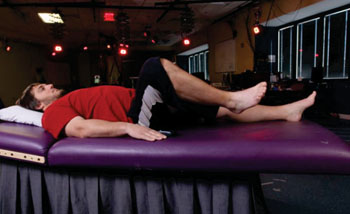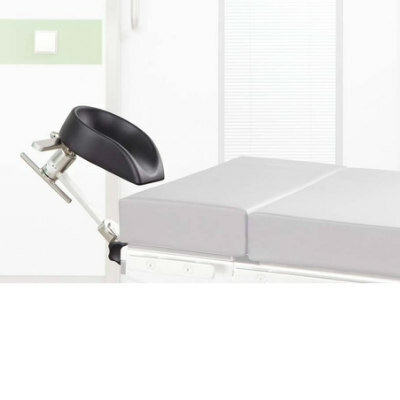Breakthrough Therapy Allows Paraplegics to Move Their Legs
|
By HospiMedica International staff writers Posted on 07 May 2014 |

Image: Kent Stephenson, the second person to undergo epidural stimulation of the spinal cord, voluntarily raises his leg (Photo courtesy of KSCIRC).
Epidural electrical stimulation of the spinal cord has allowed four young men who have been paralyzed for years to move their legs voluntarily.
Researchers at the University of Louisville (UL; KY, USA), The University of California, Los Angeles (UCLA, USA), and the Pavlov Institute of Physiology (Saint Petersburg, Russia) implanted an epidural stimulator delivering a continuous electrical current to lower spinal cords of the participants, who were classified as suffering from chronic, motor complete spinal cord injuries, and were unable to move their lower extremities. Once the signal was triggered, the spinal cord reengaged its neural network, allowing the participants to control and direct muscle movements.
In epidural stimulation, an electrical current is applied at varying frequencies and intensities to specific locations on the lumbosacral spinal cord, corresponding to the dense neural bundles that largely control the movement of the hips, knees, ankles and toes. Coupling epidural stimulation with rehabilitative therapy intensified therapy impact, and participants were able to initiate movement with less stimulation, demonstrating the ability of the spinal network to learn and improve nerve functions. Beyond regaining voluntary movement, the participants enjoyed overall health improvement, including increased muscle mass, blood pressure regulation, reduced fatigue, and dramatic improvements in their sense of well-being.
The study builds on initial research—published in May 2011 in the Lancet—that evaluated the effects of epidural stimulation in the first participant, Rob Summers of Portland (OR, USA), who recovered a number of motor functions as a result of that intervention. Three years later, the new study reports the impact of epidural stimulation on Summers and another three participants, who were all able to execute voluntary movements immediately following implantation and activation of the stimulator. The participants' results and recovery time were unexpected, which led researchers to speculate that some pathways may be intact post-injury and therefore able to facilitate voluntary movements. The study was published in the April 4, 2014, issue of Brain.
“Two of the four subjects were diagnosed as motor and sensory complete injured with no chance of recovery at all,” said lead author Claudia Angeli, PhD, an assistant professor at the UL Kentucky Spinal Cord Injury Research Center (KSCIRC). “Because of epidural stimulation, they can now voluntarily move their hips, ankles, and toes. This is groundbreaking for the entire field and offers a new outlook that the spinal cord, even after a severe injury, has great potential for functional recovery.”
"This is a wake-up call for how we see motor complete spinal cord injury,” said coauthor V. Reggie Edgerton, PhD, distinguished professor of integrative biology and physiology, neurobiology, and neurosurgery at UCLA. “We don't have to necessarily rely on regrowth of nerves in order to regain function. The fact that we've observed this in four out of four people suggests that this is actually a common phenomenon in those diagnosed with complete paralysis.”
“This research brings up an amazing number of possibilities for how we can develop interventions that will help people recover movement they have lost,” added Dr. Edgerton, who is also a member of the Reeve Foundation (Short Hills, NJ, USA) International Research Consortium on Spinal Cord Injury, which helped fund the research. “The circuitry in the spinal cord is remarkably resilient. Once you get them up and active, many physiological systems that are intricately connected and that were dormant come back into play.”
Related Links:
University of Louisville
The Pavlov Institute of Physiology
Reeve Foundation
Researchers at the University of Louisville (UL; KY, USA), The University of California, Los Angeles (UCLA, USA), and the Pavlov Institute of Physiology (Saint Petersburg, Russia) implanted an epidural stimulator delivering a continuous electrical current to lower spinal cords of the participants, who were classified as suffering from chronic, motor complete spinal cord injuries, and were unable to move their lower extremities. Once the signal was triggered, the spinal cord reengaged its neural network, allowing the participants to control and direct muscle movements.
In epidural stimulation, an electrical current is applied at varying frequencies and intensities to specific locations on the lumbosacral spinal cord, corresponding to the dense neural bundles that largely control the movement of the hips, knees, ankles and toes. Coupling epidural stimulation with rehabilitative therapy intensified therapy impact, and participants were able to initiate movement with less stimulation, demonstrating the ability of the spinal network to learn and improve nerve functions. Beyond regaining voluntary movement, the participants enjoyed overall health improvement, including increased muscle mass, blood pressure regulation, reduced fatigue, and dramatic improvements in their sense of well-being.
The study builds on initial research—published in May 2011 in the Lancet—that evaluated the effects of epidural stimulation in the first participant, Rob Summers of Portland (OR, USA), who recovered a number of motor functions as a result of that intervention. Three years later, the new study reports the impact of epidural stimulation on Summers and another three participants, who were all able to execute voluntary movements immediately following implantation and activation of the stimulator. The participants' results and recovery time were unexpected, which led researchers to speculate that some pathways may be intact post-injury and therefore able to facilitate voluntary movements. The study was published in the April 4, 2014, issue of Brain.
“Two of the four subjects were diagnosed as motor and sensory complete injured with no chance of recovery at all,” said lead author Claudia Angeli, PhD, an assistant professor at the UL Kentucky Spinal Cord Injury Research Center (KSCIRC). “Because of epidural stimulation, they can now voluntarily move their hips, ankles, and toes. This is groundbreaking for the entire field and offers a new outlook that the spinal cord, even after a severe injury, has great potential for functional recovery.”
"This is a wake-up call for how we see motor complete spinal cord injury,” said coauthor V. Reggie Edgerton, PhD, distinguished professor of integrative biology and physiology, neurobiology, and neurosurgery at UCLA. “We don't have to necessarily rely on regrowth of nerves in order to regain function. The fact that we've observed this in four out of four people suggests that this is actually a common phenomenon in those diagnosed with complete paralysis.”
“This research brings up an amazing number of possibilities for how we can develop interventions that will help people recover movement they have lost,” added Dr. Edgerton, who is also a member of the Reeve Foundation (Short Hills, NJ, USA) International Research Consortium on Spinal Cord Injury, which helped fund the research. “The circuitry in the spinal cord is remarkably resilient. Once you get them up and active, many physiological systems that are intricately connected and that were dormant come back into play.”
Related Links:
University of Louisville
The Pavlov Institute of Physiology
Reeve Foundation
Latest Critical Care News
- Glowing Bacteria ‘Pills’ for Detecting Gut Diseases Could Eliminate Colonoscopies
- Skin-Permeable Polymer Patch Delivers Insulin Non-Invasively Through Skin
- Nanogel Technology Almost 100% Effective in Destroying Drug-Resistant Bacteria Within Hours
- Wearable Ultrasound Sensor Delivers Noninvasive Treatment Without Surgery
- Gel-Free ECG System to Transform Heart Health Diagnosis
- Biodegradable Patch Repairs Damaged Tissue After Heart Attack
- Magnetically Guided Microrobots to Enable Targeted Drug Delivery

- Smart Nanomaterials Detect and Treat Traumatic Brain Injuries Simultaneously
- Earlier Blood Transfusion Could Reduce Heart Failure and Arrhythmia in Heart Disease Patients
- 'Smart' Shirt Detects Epileptic Seizures in Real Time
- Skin Patch Measures Effectiveness of Flu/COVID Vaccines in 10 Minutes
- Complete Revascularization Reduces Risk of Death from Cardiovascular Causes
- Tiny Fish-Inspired Robots Navigate Through Body to Deliver Targeted Drug Therapy
- Coronary Artery Stenosis Could Protect Patients from Pulmonary Embolism Effects
- Sweat-Powered Sticker Turns Drinking Cup into Health Sensor
- Skin-Mounted 3D Microfluidic Device Analyzes Sweat for Real-Time Health Assessment
Channels
Surgical Techniques
view channelNovel Endoscopy Technique Provides Access to Deep Lung Tumors
Detecting lung cancer early can save lives, but diagnosing small tumors deep in the outer regions of the lungs remains a major clinical challenge. Although CT scans frequently identify tiny suspicious... Read more
New Study Findings Could Halve Number of Stent Procedures
When a coronary artery becomes acutely blocked during a heart attack, opening it immediately is essential to prevent irreversible damage. However, many patients also have other narrowed vessels that appear... Read morePatient Care
view channel
Revolutionary Automatic IV-Line Flushing Device to Enhance Infusion Care
More than 80% of in-hospital patients receive intravenous (IV) therapy. Every dose of IV medicine delivered in a small volume (<250 mL) infusion bag should be followed by subsequent flushing to ensure... Read more
VR Training Tool Combats Contamination of Portable Medical Equipment
Healthcare-associated infections (HAIs) impact one in every 31 patients, cause nearly 100,000 deaths each year, and cost USD 28.4 billion in direct medical expenses. Notably, up to 75% of these infections... Read more
Portable Biosensor Platform to Reduce Hospital-Acquired Infections
Approximately 4 million patients in the European Union acquire healthcare-associated infections (HAIs) or nosocomial infections each year, with around 37,000 deaths directly resulting from these infections,... Read moreFirst-Of-Its-Kind Portable Germicidal Light Technology Disinfects High-Touch Clinical Surfaces in Seconds
Reducing healthcare-acquired infections (HAIs) remains a pressing issue within global healthcare systems. In the United States alone, 1.7 million patients contract HAIs annually, leading to approximately... Read moreHealth IT
view channel
EMR-Based Tool Predicts Graft Failure After Kidney Transplant
Kidney transplantation offers patients with end-stage kidney disease longer survival and better quality of life than dialysis, yet graft failure remains a major challenge. Although a successful transplant... Read more
Printable Molecule-Selective Nanoparticles Enable Mass Production of Wearable Biosensors
The future of medicine is likely to focus on the personalization of healthcare—understanding exactly what an individual requires and delivering the appropriate combination of nutrients, metabolites, and... Read moreBusiness
view channel
Philips and Masimo Partner to Advance Patient Monitoring Measurement Technologies
Royal Philips (Amsterdam, Netherlands) and Masimo (Irvine, California, USA) have renewed their multi-year strategic collaboration, combining Philips’ expertise in patient monitoring with Masimo’s noninvasive... Read more
B. Braun Acquires Digital Microsurgery Company True Digital Surgery
The high-end microsurgery market in neurosurgery, spine, and ENT is undergoing a significant transformation. Traditional analog microscopes are giving way to digital exoscopes, which provide improved visualization,... Read more
CMEF 2025 to Promote Holistic and High-Quality Development of Medical and Health Industry
The 92nd China International Medical Equipment Fair (CMEF 2025) Autumn Exhibition is scheduled to be held from September 26 to 29 at the China Import and Export Fair Complex (Canton Fair Complex) in Guangzhou.... Read more















